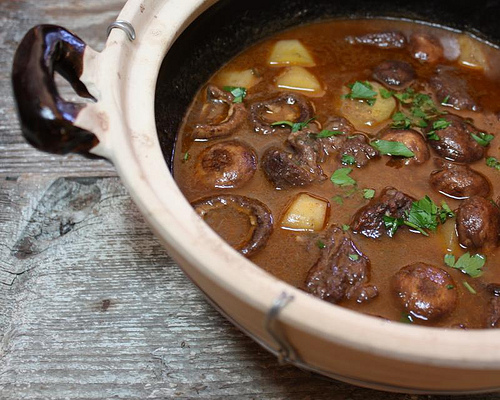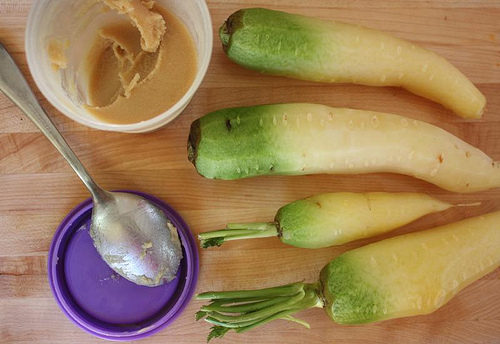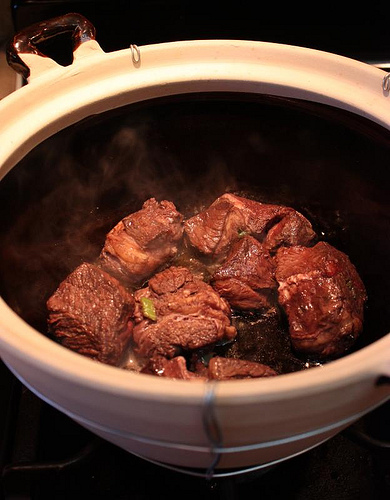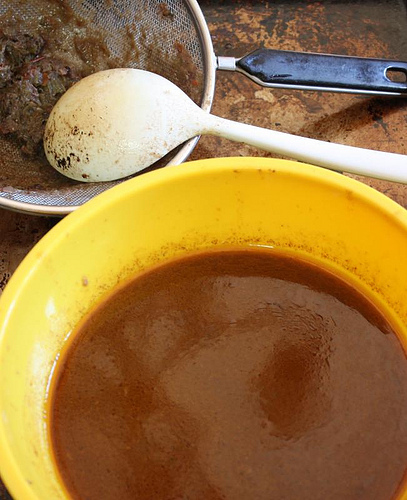
Because of France’s occupation of Vietnam from 1883 to 1954, many people assume that Viet cooking is heavily influenced by French foodways. While there are a handful of old French cookbooks written in Vietnamese, pure French cooking was mostly for those who could afford the ingredients.
As cultural survivalists, Vietnamese cooks wove French elements into their traditions, just like they did with other cultures that they came in contact with over the ages. That’s why Vietnamese food can confound as much as it delights. Beefy classics such as pho noodle soup and beef stew with tomato, lemongrass, and star anise are prime examples of fusion Vietnamese fare. There are so many Eastern and Western elements in those dishes that it's hard to simply call them Viet-Franco food.
On the other hand, Viet cooks can be inventive in replicating foreign culinary concepts, such as a beouf Bourguinon. That’s what I pondered as I set about making a red wine and beef stew, an cool weather dish that seemed fitting with the season. I typically rely on Julia Child’s master Zinfandel of Beef recipe from The Way to Cook when making a beef stew. This time around, I combined JC’s techniques with some borrowed from Jennifer McLagan’s new book, Odd Bits: How to Cook the Rest of the Animal. While there are a number of Asian-inspired recipes, most of McLagan’s recipes are western in nature. The point of the book is to encourage cooks to look beyond the usual “middle cuts,” such as beef and pork tenderloin, to discover the delicious appeal of ears, tongues, feet, and tails.
Asian cooks don’t have much issue with this concept as evidenced by the tripe and chicken feet at dim sum! Nevertheless it's good to be reminded of their exceptional flavor and textures. Asian markets have a wealth of odd bits but how often do we buy them nowadays? Not as much as our parents and grandparents used to as they practiced a head-to-tail approach to eating.
McLagan’s classic beef stew recipe was unfussy, called for igniting the red wine (pyrotechnic cooking always intrigues me), and baking the stew. She used rounds of beef shank. I had this frozen chuck roast from my annual share of a grass-fed cow:

As I was reviewing the recipes by Child and McLagan, I thought: How would I make this dish if I lived in Vietnam during the French colonial period? What if I had to cook for or with a French person during that era?
The French person would likely contribute certain things like the wine, parsley (ngo tay/rau mui tay, western cilantro), bay leaf (la thom, fragrant leaf) and perhaps thyme brought over from France. The tenderloin would have been used for bifteks, and tougher cuts like my chuck roast would be stewed; Viet cows are pasture fed so my 100% grass-fed beef was a very good substitute. With those ingredients and what I had on hand, we’d probably create the red wine and beef stew with some touches from my Viet kitchen for a Franco-Viet iteration.
Keeping those assumptions in mind, I made these tweaks to my usual red wine and beef stew:
Claypot: Home ovens were (and still are) rarities in Vietnam. Simmering the stew in a claypot would be my work around for baking the stew in an oven. The claypot I used has a capacity of about 4 ½ quarts. It browned the meat okay but I couldn’t get to heat up hot enough as my usual stew pot: an enamel coated cast iron Dutch oven similar to this one.
Fish sauce: Red wine, aromatics, salt, and pepper season the stew but to ensure umami depth, a few shots of nuoc mam were needed.
Extra black pepper: Vietnam grows wonderful black pepper, especially from Phu Quoc island. To add a touch of heat, I doubled the amount of black peppercorns from ¼ to ½ teaspoon and liberally sprinkled freshly ground pepper on the meat before browning.
Beef pho broth: In lieu of beef stock, I reached for beef pho broth, which I had frozen. The spices would build a nice layer of flavor. (If you want to fudge this, simmer canned beef or chicken broth with a little water (2:1 ratio) with the spices you’re normally use in those pho broths. See the beef and chicken pho recipes for guidance. Simmer the quickie broth for 8 to 10 minutes then strain .)
Parsley, cilantro and rau ram: Why not blend western and eastern parsleys together? Flat-leaf parsley is called for in western beef stews but a little cilantro addition wouldn’t hurt. For garnish, rau ram and/or flat-leaf parsley could lend a fresh finish to the stew.
Fresh tomato instead of tomato paste: McLagan’s recipe asked for a tablespoon of tomato paste. I had some little dry-farmed tomatoes around and figure that a Viet cook would use fresh tomato. Tomato paste is not common in Vietnam.
Lard: McLagan champions beef drippings or lard for her stew. In Vietnam, lard was a traditional cooking fat. I had some from a Mexican market in the fridge.
 Along with the lard, I had some yellow carrots purchased from the farmer's market.
Along with the lard, I had some yellow carrots purchased from the farmer's market.
Banana leaf vs. parchment paper: A parchment paper round is placed atop the stew during simmering to seal in moisture. I could have used soft banana leaf if I didn’t have parchment but in actually, I had parchment but no banana leaf in my kitchen! The banana leaf would have added a slight tea-like flavor, which I think would have been fine.
The result? Really really tasty. Actually, my husband deemed the red wine and beef stew to be “absolutely delicious.” He wasn’t just saying that to be kind.
What I learned from this Franco-Viet experiment is that finessing and adapting classic preparations well is a matter of cooking within parameters. What if I didn’t have an oven? I’d find a cooking vessel that closely approximated that kind of heat. No beef stock? Why not use readily available pho broth? Such substitutes are not meant to replicate a classic boeuf Bourguinon. However, you get a darn lovely beef stew for dinner. We mopped up the sauce with Acme baguette and served Brussels sprouts on the side.
RECIPE
Red Wine and Beef Stew in Claypot
Feel free to substitute 3 pounds of boneless beef shin (sold at Asian markets). Do the initial simmer for 1 ½ to 1 ¾ hours since shin takes a little longer than beef chuck to cook, which is cut from the shoulder.
Serves 6
2 cups red wine
3 ¾ pounds beef chuck roast, deboned and cut into 2-inch chunks (3 pounds total)
2 large onions (1 ⅓ pounds total)
2 ribs celery, sliced
3 large cloves garlic, crushed
3 sprigs Italian (flat-leaf) parsley
2 bushy sprigs thyme
8 to 10 sprigs cilantro (optional)
1 bay leaf
½ teaspoon black peppercorns
Salt and pepper
Fish sauce
4 to 5 tablespoons lard or canola oil
1 tablespoon tomato paste, or 1 ripe tomato
2 cups beef stock or pho broth
4 carrots, cut into ¾ to 1-inch-thick pieces
12 ounces crimini (brown) mushroom, stems removed
¼ cup chopped Italian (flat-leaf) parsley, cilantro and/or rau ram leaves, for garnish
1. Bring the wine to a boil in a large saucepan. Lower the heat so the wine gently bubbles. Tilt the pan slightly away from you and light the wine on the surface. (Use a long lighter or match.)

Once the flame dies out, light the wine again. Repeat until it no longer flames. Set aside to cool.
2. In a large bowl, combine the beef with 1 of the sliced onion, celery, garlic, parsley, thyme, cilantro, bay leaf, and peppercorns. Add the wine. Use your hands to mix well. Let marinate for 3 hours on the counter, giving it a stir midway. Or cover and refrigerate overnight, returning it to room temperature before proceeding; stir it in the morning.
3. Remove the meat from the marinade. Strain the marinade, reserving the solids. Pat the meat dry with paper towels. Season it with salt, pepper, and a few shots of fish sauce.
4. Heat about 1 tablespoon of lard in the claypot over medium-low heat, then increasing it gradually to medium-high. (If you’re using a enamel cast iron pot, just heat it over medium-high heat.) In batches, brown the beef, setting it aside when done. Add more lard as needed.

5. Add the remaining sliced onion along with the reserved onion and aromatics from the marinade to the claypot. Cook, stirring occasionally, until the onion has softened. Put the lid on, if needed.
6. Add the tomato and cook till it softens is no longer solid. Add the wine, stock, and beef. Bring to a boil. Place a parchment paper round on the surface, pressing down on it so it gets damp enough to soften and adhere to the stew. Cover, then lower the heat to gently simmer for 1 ¼ hours, until barely tender.
7. Uncover, remove and discard the parchment. Add the carrots and simmer for 30 to 40 minutes, until the carrots and beef are both tender. Meanwhile, sear the mushroom in a skillet over high heat until they’ve softened slightly. Sprinkle on a little salt while searing. Set aside.
8. Turn off the heat. Let the stew cool for a bit, then remove the beef and carrots. Strain the cooking liquid through a mesh strainer, pressing on the solids.

If you like, mash the solids so that most of it goes through the strainer to thicken the sauce a bit. If you want, wait for fat to shimmer on top and skim it off.
Wash the claypot, then return the sauce, beef, and carrots. Add the mushroom. Reheat the stew, gently simmer it for 15 minutes or so to develop the flavor. Season with salt and pepper, maybe a little fish sauce, then sprinkle with the herb garnish of your choice.
How would you tweak the beef stew if you were in Vietnam during that period? I’m sure you’d be more creative than I was.
Related recipes:

















Erica Peters says
Great post, Andrea!
Andrea Nguyen says
@Erica_Peters: Funny you should react that way. I thought of you and your upcoming book when I was writing up this post!
sewing says
Your description about the recipe is perfect one.Its easy to us to make it at our home.It looks testy and yummy also thanks for sharing.
Simon Bao says
Interesting intellectual challenge Andrea, the kind of "mind game" I like playing all the time.
I think I might cut back on the amount of sliced onion, and replace them with whole peeled shallots, added to my stew much as many cooks use whole pearl onions in Beef Bourguignon. (Did we have pearl onions in VN?)
A chef in Vietnam might use Chinese/Oriental celery in lieu of the American/European variety... but then hopefully use much less of it. And a chef in VN would also certainly have the brandy that's used in some recipes. (Now THAT is what I call a flame!)
What mushroom would a chef in Vietnam use, either in 1911 or in 2011?
Andrea Nguyen says
Simon, I halved the amount of onions from the original recipe. The yellow oinions in Vietnam were and still are called Western onions: hanh Tay. A little parsley could be had too, albeit it would have likely been scrawny.
Fresh mushroom, such as straw or shiitake, could be used in Vietnam. I thought about it but only had dried shiitake, which are too robust for this. Fresh shiitake at my non-Asian market was pricey; I didn't want to trek 1hr roundtrip to an Asian market as that would have defeated the purpose somewhat.
The shallots in Vietnam are more like the size of boiling onions. So here, you could sub red pearl onions since our shallots are giants.
True Religion outlet says
they plan to win! More than a dozen Democrats who lost by thin margins in 2010 are looking for a rematch. They know that 2010 was lightning in a bottle for the Tea Party and the Republicans - and they will never repeat that again. The Tea Party failure, the Republican impotence, has been on display for a year.
3d photo editor says
Yummy... Red Wine and Beef Stew in Claypot is my one of the favorite recipe. I always eat Red Wine and Beef Stew in Claypot for every month.
3d photo editor says
Yummy... Red Wine and Beef Stew in Claypot is my one of the favorite recipe. I always eat Red Wine and Beef Stew in Claypot for every month.
kamagra online says
Hmmm, I really like your posts, but how can I add your site to my favorites? kamagra jelly
Binh says
How does one flambé red wine? Most red is about 15% and can't ignite.
Mr. Cooking Grill says
wow so meaty! i love to taste some of this! 🙂
marlon says
That recipe tastes good! i really love this blog! it helps me on having a new recipe for my family!
marlon says
That one really tastes good!
Nickle says
i cant wait to try this on weekend 🙂